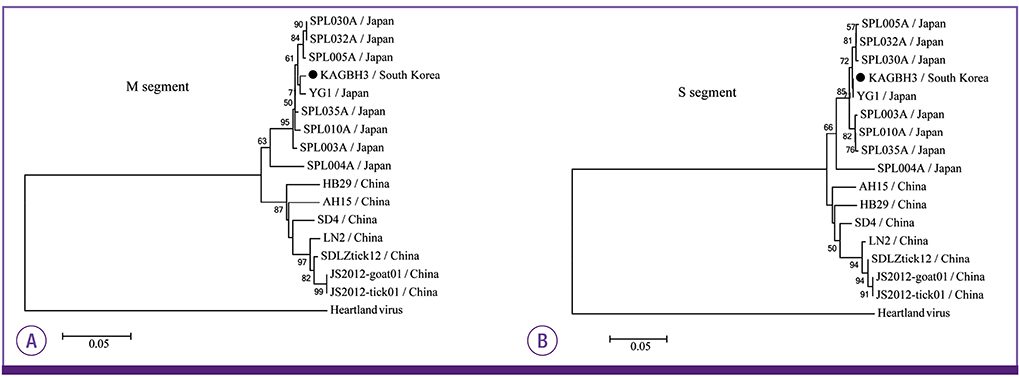Infect Chemother.
2016 Dec;48(4):338-341. 10.3947/ic.2016.48.4.338.
Severe Fever with Thrombocytopenia Syndrome Presenting with Hemophagocytic Lymphohistiocytosis
- Affiliations
-
- 1Department of Internal Medicine, Ulsan University Hospital, University of Ulsan College of Medicine, Ulsan, Korea. uvgotletter@hanmail.net
- 2Department of Laboratory Medicine, Ulsan University Hospital, University of Ulsan College of Medicine, Ulsan, Korea.
- 3Division of Hematology and Hematological Malignancies, Department of Hematology and Oncology, Ulsan University Hospital, University of Ulsan College of Medicine, Ulsan, Korea.
- 4Division of Arboviruses, Center for Immunology and Pathology, National Institute of Health, Korea Centers for Disease Control and Prevention, Cheongju, Korea.
- KMID: 2441330
- DOI: http://doi.org/10.3947/ic.2016.48.4.338
Abstract
- Severe fever with thrombocytopenia syndrome (SFTS) is an emerging tick-borne disease caused by the newly discovered SFTS Bunyavirus, and there have been no case reports of SFTS patients presenting with hemophagocytic lymphohistiocytosis (HLH) in the English literature. We report a case of SFTS presenting with HLH in a 73-year-old immunocompetent male farmer. Although the patient had poor prognostic factors for SFTS, such as old age and central nervous system symptoms, he recovered fully with supportive care.
MeSH Terms
Figure
Reference
-
1. Yu XJ, Liang MF, Zhang SY, Liu Y, Li JD, Sun YL, Zhang L, Zhang QF, Popov VL, Li C, Qu J, Li Q, Zhang YP, Hai R, Wu W, Wang Q, Zhan FX, Wang XJ, Kan B, Wang SW, Wan KL, Jing HQ, Lu JX, Yin WW, Zhou H, Guan XH, Liu JF, Bi ZQ, Liu GH, Ren J, Wang H, Zhao Z, Song JD, He JR, Wan T, Zhang JS, Fu XP, Sun LN, Dong XP, Feng ZJ, Yang WZ, Hong T, Zhang Y, Walker DH, Wang Y, Li DX. Fever with thrombocytopenia associated with a novel bunyavirus in China. N Engl J Med. 2011; 364:1523–1532.
Article2. Takahashi T, Maeda K, Suzuki T, Ishido A, Shigeoka T, Tominaga T, Kamei T, Honda M, Ninomiya D, Sakai T, Senba T, Kaneyuki S, Sakaguchi S, Satoh A, Hosokawa T, Kawabe Y, Kurihara S, Izumikawa K, Kohno S, Azuma T, Suemori K, Yasukawa M, Mizutani T, Omatsu T, Katayama Y, Miyahara M, Ijuin M, Doi K, Okuda M, Umeki K, Saito T, Fukushima K, Nakajima K, Yoshikawa T, Tani H, Fukushi S, Fukuma A, Ogata M, Shimojima M, Nakajima N, Nagata N, Katano H, Fukumoto H, Sato Y, Hasegawa H, Yamagishi T, Oishi K, Kurane I, Morikawa S, Saijo M. The first identification and retrospective study of severe fever with thrombocytopenia syndrome in Japan. J Infect Dis. 2014; 209:816–827.
Article3. Kim KH, Yi J, Kim G, Choi SJ, Jun KI, Kim NH, Choe PG, Kim NJ, Lee JK, Oh MD. Severe fever with thrombocytopenia syndrome, South Korea, 2012. Emerg Infect Dis. 2013; 19:1892–1894.
Article4. Ding F, Zhang W, Wang L, Hu W, Soares Magalhaes RJ, Sun H, Zhou H, Sha S, Li S, Liu Q, Li Q, Yang W, Huang L, Li C. Yin W.Epidemiologic features of severe fever with thrombocytopenia syndrome in China, 2011-2012. Clin Infect Dis. 2013; 56:1682–1683.
Article5. Shin JS, Park JH, Kwon DH. Epidemiologic and clinical characteristics of severe fever with thrombocytopenia syndrome in the Republic of Korea. Public Health Weekly Report. 2014; 7:493–498.6. Jordan MB, Allen CE, Weitzman S, Filipovich AH, McClain KL. How I treat hemophagocytic lymphohistiocytosis. Blood. 2011; 118:4041–4052.
Article7. QuanTai X. FengZhe C, XiuGuang S, DongGe C. A study of cytological changes in the bone marrow of patients with severe fever with thrombocytopenia syndrome. PLoS One. 2013; 8:e83020.8. Weng Y, Chen N, Han Y, Xing Y, Li J. Clinical and laboratory characteristics of severe fever with thrombocytopenia syndrome in Chinese patients. Braz J Infect Dis. 2014; 18:88–91.
Article9. Trottestam H, Horne A, Aricò M, Egeler RM, Filipovich AH, Gadner H, Imashuku S, Ladisch S, Webb D, Janka G, Henter JI. Histiocyte Society. Chemoimmunotherapy for hemophagocytic lymphohistiocytosis: long-term results of the HLH-94 treatment protocol. Blood. 2011; 118:4577–4584.
Article
- Full Text Links
- Actions
-
Cited
- CITED
-
- Close
- Share
- Similar articles
-
- Two Cases of Severe Fever with Thrombocytopenia Syndrome Manifested with Hemophagocytic Lymphohistiocytosis Successfully Treated with Steroids
- Severe Fever with Thrombocytopenia Syndrome Accompanied by Hemophagocytic Lymphohistiocytosis
- Severe Fever with Thrombocytopenia Syndrome Patients with Hemophagocytic Lymphohistiocytosis Retrospectively Identified in Korea, 2008–2013
- A case of hemophagocytic lymphohistiocytosis caused by an Epstein-Barr virus infection, presenting with unremitting fever and rash
- A Case of Hemophagocytic Lymphohistiocytosis Presenting with Neck Mass in a Child



